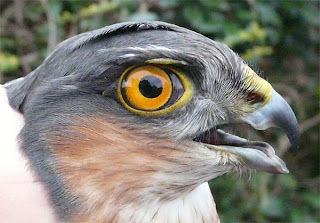Well there it is, the end of 2011 and the end of my first year of blogging. It has been an interesting year for me which included record numbers of birds ringed at Titchfield Haven, and foreign trips to Crete, Portugal and Turkey; I hope you have enjoyed my posts. I had hoped to complete two more updates from the Turkey trip, but just ran out of time, and so I thought I would end the year with a few random pictures of that trip.
In summary, I was the co-guide on a trip to central and southern Turkey for Ornitholidays. The trip included stops in four main areas, some of which I have reported on previously. This post summarises the latter part of the trip where we birded around Birecik and Gaziantep, and a few places in between.
 |
| Bald Ibis - Birecik |
Bald Ibis were very easy to see around Birecik, and at times were very confiding, whilst the scrub outside the Ibis centre sheltered migrants such as Barred and Garden Warbler.
 |
| Barred Warbler - Birecik |
Great Reed Warblers were very vocal and surprisingly visible at Tabaklar Fishponds.....
 |
| Great Reed Warbler - Tabaklar Fish Ponds |
......and excellent views of Pied and White-throated Kingfishers were gained here and at Kirmitli Bird Paradise.
 |
| Pied Kingfisher - Kirmitli Bird Paradise |
The reservoir at Nizip added a few new species to the trip list, with the most surprising being a flock of 8 Red-necked Phalarope......
 |
| Red-necked Phalarope - Nizip |
..................and the nearby pistachio fields proved to be a popular feeding place for a large flock of Yellow-throated and Dead Sea Sparrows.
 |
| Yellow-throated Sparrow - Nizip |
The scrubby valleys and olive groves on the outskirts of Gaziantep were a personal highlight for me since they provided out first views of White-throated Robin....and what a way to start, two cracking males!
 |
| White-throated Robin - Gaziantep |
 |
| White-throated Robin - Gaziantep |
Whilst watching the White-throated Robins, Long-legged Buzzards circled over head, and then settled on a cliff ledge above, where they were nesting. Cinereous Buntings, Olive-tree Warblers and both Western and Eastern Rock Nuthatches were also recorded.
 |
| Long-legged Buzzard - Gaziantep |
Other species recorded in the valleys included Isabelline, Black-eared and Finch's Wheatears.....
 |
| Isabelline Wheatear - Gaziantep |
.....and a trip specially in the form of Kurdish Wheatear.
 |
| Kurdish Wheatear - Gaziantep |
The trip ended with a trip to the local park in the centre of Birecik where we were able to locate the much sought after Pallid Scops Owl.
 |
| Pallid Scops Owl - Birecik |
And so that brings me to the end of my last post of 2011, a Happy New Year to all my readers and if you fancy meeting up in Turkey next year check out the Ornitholidays website http://www.ornitholidays.co.uk/details.asp?id=312 as I hope to be guiding this trip again next year.



























